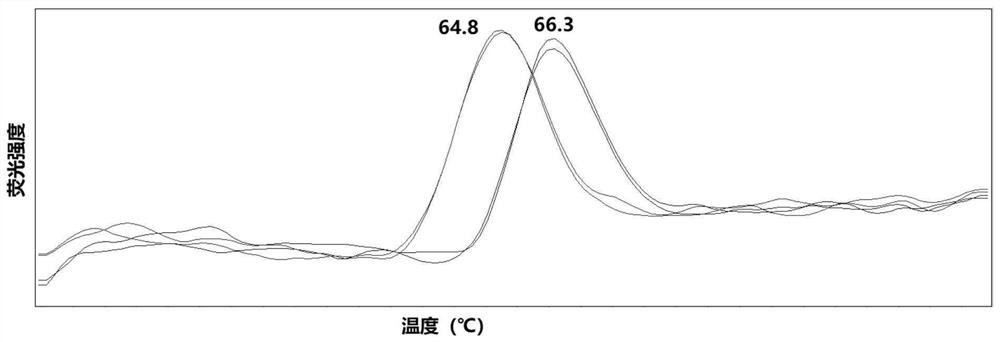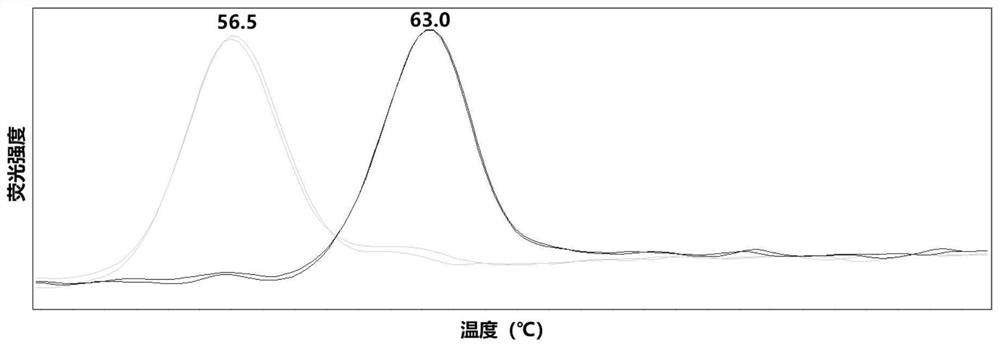Primer probe combination for detecting echinocandin drug-resistant mutation target of candida albicans and application thereof
A technology of Candida albicans and echinocandin, which is applied in the field of molecular biology detection of fungi, can solve the problems of long separation period, unfavorable rapid diagnosis, and cumbersome process of bacterial culture method, and achieves high accuracy, reasonable design, and simple steps simple effect
- Summary
- Abstract
- Description
- Claims
- Application Information
AI Technical Summary
Problems solved by technology
Method used
Image
Examples
Embodiment 1
[0070] This embodiment provides a combination of primers and probes for the detection of echinocandins drug-resistant mutation targets of Candida albicans, the combination of primers and probes includes a first primer pair, a second primer pair, a first detection probe, a second primer pair A second detection probe and a third detection probe.
[0071] In this example, among the common gene mutations that lead to echinocandin drug resistance in Candida albicans, three mutation hotspots in two hotspot mutation regions were selected as detection targets, which were F641S in the HS1 region (the corresponding nucleoside The acid mutation site is T1922C), S645P (the corresponding nucleotide mutation site is T1933C); the R1361H in the HS2 region (the corresponding nucleotide mutation site is G4082A).
[0072] Design and prepare 3 Taqman probes for the 3 targets, and design a pair of primer sequences on the periphery according to the probe sequences, including an upstream primer and ...
Embodiment 2
[0084] In this example, the combination of primers and probes provided in Example 1 was used to construct an asymmetric fluorescent quantitative PCR amplification system. The asymmetric fluorescent quantitative PCR amplification system is shown in Table 3:
[0085]Table 3 Asymmetric fluorescent quantitative PCR amplification system
[0086] components dose Taq polymerase 2U dNTP 0.2mM Primers (2 upstream primers) 200nM×2 Primers (2 downstream primers) 2μM×2 Probes (3 pieces) 100nM×3 MgCl 2
3mM Tris-HCl 15mM template 2ng DMSO 5wt% total capacity 25 μL
[0087] In addition, internal quality control products were added to the amplification system, including internally controlled upstream primers, downstream primers and corresponding probes, the concentrations of which were 200nM, 2μM and 100nM, respectively, and the specific sequences were as follows:
[0088] The internal control upstream pr...
Embodiment 3
[0101] In this example, the asymmetric fluorescent quantitative PCR amplification system constructed in Example 2 is used to amplify and detect the melting curve of the sample to be tested.
[0102] Concrete reaction process is as follows:
[0103] The first stage: pre-denaturation at 95°C for 10 minutes; 1 cycle;
[0104] The second stage: Denaturation at 95°C for 10s; extension at 55°C for 40s, fluorescence signal collection during extension, 45 cycles;
[0105] The third stage: 1 min at 95°C, 2 min at 35°C; the temperature was raised from 35°C to 95°C at 0.2°C / s, and the fluorescence signal was collected continuously, 5 times / °C.
[0106] The melting temperature corresponding to the F641S target wild type and mutant type is as follows figure 1 As shown, the melting temperatures corresponding to the wild-type and mutant types of the S645P target are as follows figure 2 as shown, image 3 The melting temperature corresponding to the R1361H target wild type and mutant ty...
PUM
 Login to View More
Login to View More Abstract
Description
Claims
Application Information
 Login to View More
Login to View More - R&D
- Intellectual Property
- Life Sciences
- Materials
- Tech Scout
- Unparalleled Data Quality
- Higher Quality Content
- 60% Fewer Hallucinations
Browse by: Latest US Patents, China's latest patents, Technical Efficacy Thesaurus, Application Domain, Technology Topic, Popular Technical Reports.
© 2025 PatSnap. All rights reserved.Legal|Privacy policy|Modern Slavery Act Transparency Statement|Sitemap|About US| Contact US: help@patsnap.com



